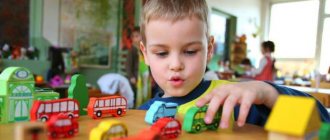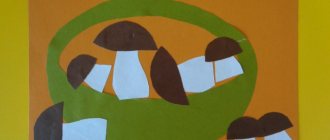Long-term planning of experiments in the middle group for the academic year
Long-term planning of experiments in the middle group for the academic year
September
1. “What is water like?” Goal: to identify the properties of water (transparent, odorless, flowing, substances dissolve in it).
2. “Oh, the wind is a breeze” (games with a fan and plumes). Goal: to introduce children to one of the properties of air - movement; air movement is wind.
3. “Sunny, smile!” Goal: to determine which objects heat up better (light or dark), where it happens faster (in the sun or in the shade).
4. “Properties of sand” Purpose: to introduce the properties of sand (consists of grains of sand, loose, small, easily crumbles, allows water to pass through, marks remain on the sand, sticks together, wet is darker than dry).
October
1. “Wonderful bag” Purpose: to introduce the senses and their purpose.
2. “Let's play with the breeze” Purpose: to detect air movement in nature.
3. "Night/day". Purpose: to introduce the meaning of light, to light sources (sun, flashlight, candle, lamp), to show that light does not pass through opaque objects.
4. “Autumn is bad weather” (why is it dirty in autumn?) Purpose: to introduce the fact that the soil allows water to pass through differently.
November
1. “Magic tablets”. Goal: use your fingers to determine the shape and structure of the surface.
2. “Air feather.” Goal: to show that objects can be light and heavy, to teach how to determine the weight of objects and group objects by weight.
3. “Ding-dong” (find by sound). Purpose: to identify and distinguish noise sounds made.
4. “Clay, its qualities and properties” Purpose: to teach to recognize objects made of clay, to determine the quality of clay (softness, plasticity, degree of strength) and properties (crumples, breaks, gets wet).
December
1. “Hot and cold” Purpose: to teach how to determine the temperature of substances and objects.
2. “Wonderful bag” Purpose: to introduce objects that conduct heat; identify the hardest object by touch.
3. “Let’s color the water.” Goal: to find out the properties of water (water is transparent, but can change its color when colored substances dissolve in it).
4. “Snow, snow.” Purpose: to introduce the properties of snow during a snowfall (white, fluffy, cold, sticky, melts in warmth).
January
1. “Games with a straw” Purpose: to give an idea that people breathe air by inhaling it with their lungs; the air can be felt and seen.
2. “Snow.” What is he like? Purpose: to introduce the properties of snow in frosty weather (cold, shiny, sparkling, crumbly, difficult to mold)
3. “How to get water from snow” Goal: to form the simplest ideas about the properties of snow (melts in heat).
4. “How to turn water into ice” Purpose: to introduce the properties of water (turns into ice at low temperatures).
February
1. “Let’s decorate the area” (making colored ice floes). Purpose: to introduce one of the properties of water.
2. “Frost and Snow.” Goal: to consolidate knowledge about the properties of snow depending on air temperature.
3. “Properties of ice.” Purpose: to introduce the properties of ice (ice is solid water, ice melts in heat), to learn to establish the simplest patterns.
4. “The wind walks across the sea” Purpose: to introduce children to such a natural phenomenon as wind, to teach them to distinguish its strength.
March
1. “Floats and sinks” Purpose: to teach children to identify light and heavy objects (some remain on the surface of the water, others drown)
2. “Magic paper” (paper, its qualities and properties). Goal: to teach to recognize objects made of paper, determine its qualities (color, smoothness, thickness, absorbency) and properties (crumples, tears, cuts, burns).
3. “Gardeners.” Purpose: to clarify ideas about the bulb, to show the need for light and water for the growth and development of plants.
4. “Sail, sail the boat.” Goal: to develop an understanding of the weight of objects.
April
1. “Hello, sunny bunny” Purpose: to give an idea that a “sunny bunny” is a ray of sunlight reflected from a mirror surface.
2. “One, two, three, four, five, we will count the sheets.” Goal: observe the appearance of leaves on branches placed in water.
3. “Wood, its qualities and properties” Purpose: to teach to recognize objects made of wood, to determine its quality (hardness, surface structure; thickness, degree of strength) and properties (cuts, burns, does not break, does not sink in water).
4. “What’s hidden?” (air in the bag). Purpose: to give children the concept that the air is around us, it can be cold, warm, humid.
May
1. “Hide the button” Purpose: to promote the accumulation of ideas about the properties of water (liquid, transparent, colorless), water changes color.
2. “I’ll bake a pie and treat you, my friend.” Goal: expand knowledge about the properties of sand, develop the ability to handle it, compare, and draw conclusions.
3. “Comparison of sand, soil and clay” Purpose: to introduce the properties of sand, soil and clay.
4. “What was the dress made from?” Goal: to teach to recognize things made of fabric, to determine its quality (thickness, degree of strength, softness) and properties (wrinkles, cuts, tears, gets wet, burns).
Get text
Comprehensive thematic planning for experimentation for children 4-5 years old
| Month | No. A week | Subject | Goals and objectives | Content | Literature |
| September | 1 | We smell, we taste, we touch, we listen | To consolidate children's understanding of the senses, their meaning (ears - to hear, recognize various sounds; nose - to detect smell) | Game "Guess what it sounds like" Game "Guess by smell" | Experimental activity author Tugusheva G.P. Chistyakova A.E.St9 |
| September | 2 | We smell, we taste, we touch, we listen | Continue to consolidate children’s ideas about the senses, their meaning (fingers - determine the shape, surface structure; tongue - determine the taste) | Game "Guess the taste" Game “Guess by touch” | Experimental activity author Tugusheva G.P. St9 |
| September | 3 | Why does everything sound? | Bring children to understand the causes of sound: vibration of an object. | Game "What does it sound like?" | Experimental activities Tugusheva G.P. St10 |
| September | 4 | Why does everything sound? | Bring children to understand the causes of sound: vibration of an object. | Game "What does it sound like?" | Experimental activities Tugusheva G.P. St10 |
Development of cognitive and research activities.
Explanatory note
The section “Development of cognitive and research activities” is also an integral part of the educational direction “Cognition”. Children's research projects are an effective and didactically justified teaching method. Research activities develop children’s cognitive activity, teach them to act independently, plan work and bring it to a positive result, and show initiative and creativity.
The main goal of this section is to develop the need for research activities in preschool children.
The goal is achieved through solving the following tasks:
— creating methodologically competent conditions for children’s experimentation in the classroom and in children’s independent creative activities;
— developing the ability to formalize the results of research activities;
— creating conditions for the presentation of research results;
— involving parents in participating in the child’s research activities.
At the end of the year, children can:
• independently repeat the experiments done together with adults;
• to make plan
research work, making diagrams and sketches;
• compare the results of observations, compare, analyze, draw conclusions and generalizations
| Month | No. A week | Subject | Goals and objectives | Content | Literature |
| October | 5 | Clear water | Identify the properties of water (transparent, odorless, pours, has weight). | Game “Who is this droplet? What does she like to play with?”Game “Find out and name” Game “What kind of water?” | Experimental activity author Tugusheva G.P. St11 |

